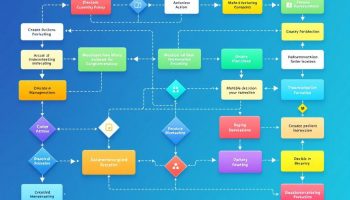
Understanding Performance Improvement Plans
Writing a performance improvement plan for employees creates a structured framework to address underperformance while developing a clear path for professional growth. These formal documents outline specific performance issues, set clear expectations, and detail the support and resources needed for employees to meet organizational standards.
How Performance Improvement Plans Drive Organizational Success
Writing a performance improvement plan for employees is crucial for maintaining workplace productivity and creating a culture of accountability. When implemented correctly, PIPs function as effective management tools that transform struggling team members into valuable contributors while offering legal protection for your organization. Instead of being seen as punishment, effective PIPs show your company’s dedication to employee development, potentially cutting turnover costs and keeping valuable institutional knowledge.
By setting clear expectations and offering appropriate support, these plans connect individual performance to broader business goals, strengthening your organization’s foundation for long-term growth. Performance improvement plans can turn challenging situations into opportunities for both employees and the company.
Companies that adopt a structured approach to performance management see a 14% increase in productivity among employees compared to those that do not.
Writing a Performance Improvement Plan for Employees: Essential Steps for Success
Creating an effective performance improvement plan (PIP) for employees requires balance and precision. A properly structured PIP serves as both a correction mechanism and growth opportunity that helps underperforming staff understand their gaps while giving them clear paths to success. When you’re writing a performance improvement plan for employees, focus on specific, measurable outcomes instead of general criticisms. Your plan should establish concrete goals, detailed action steps, and reasonable timeframes that challenge staff while remaining attainable. Well-executed PIPs can transform potential termination situations into chances for professional development and renewed employee commitment.
The right approach to performance improvement combines accountability with support, creating a framework that drives meaningful change through logical progression – from identifying issues to evaluating outcomes and determining appropriate next actions based on results.
1. Identify and Document Performance Issues
When writing a performance improvement plan for employees, the first critical step is gathering concrete evidence of performance issues. Document specific incidents with dates, times, and detailed descriptions of the problematic behavior. Review the employee’s past performance evaluations to identify patterns or recurring issues that need addressing.
Be thorough in documenting behavioral patterns that impact workplace efficiency. For example, track instances of missed deadlines, quality issues, or inappropriate workplace conduct. Consider implementing an effective action log to monitor ongoing performance concerns.
When documenting performance issues, assess how these behaviors affect:
- Team productivity and morale
- Quality of work and deliverables
- Customer satisfaction metrics
- Company culture and workplace atmosphere
- Achievement of departmental goals
The strength of your performance improvement plan depends on your ability to clearly identify and document these issues with specific evidence rather than general impressions or hearsay. This foundation of concrete examples helps ensure both parties understand exactly what behaviors need to change.
2. Set Clear SMART Goals and Expectations
When writing a performance improvement plan for employees, establishing precise objectives is essential. Your PIP should include specific performance targets that clearly describe what the employee needs to accomplish. For example, instead of writing “improve customer service,” specify “reduce customer complaint rate by 15% within 60 days.”
Establish measurable success metrics that allow both you and the employee to track progress objectively. These metrics create accountability and provide clear evidence of improvement or continued challenges. Consider implementing critical success factors to ensure these metrics align with broader organizational objectives.
Set realistic and achievable timeframes that challenge the employee while remaining attainable. Unreasonable deadlines will only frustrate efforts and potentially worsen performance issues. Your timeframes should:
- Allow sufficient time for meaningful change
- Include milestone checkpoints
- Consider the complexity of required improvements
- Account for any training or resource acquisition periods
Align goals with role requirements to ensure the improvement plan addresses core job functions. This helps demonstrate how performance improvements directly connect to the employee’s position and organizational success.
Finally, create tangible benchmarks that break larger goals into smaller, manageable achievements. These stepping stones provide motivation through incremental wins and help maintain momentum throughout the performance improvement process.
Expert Insight: Set SMART goals in performance improvement plans to provide clarity and measurable success. Ensure objectives are specific, realistic, and aligned with role requirements, incorporating accountability metrics. Break larger goals into achievable milestones to maintain motivation and monitor progress effectively.
3. Develop an Action Plan and Support System for Performance Improvement
After identifying performance issues and setting SMART goals, the next crucial step in writing a performance improvement plan for employees is developing a comprehensive action plan with proper support. When writing a performance improvement plan, create a detailed roadmap that outlines specific steps the employee must take to achieve success.
Begin by documenting the required improvement actions in clear, sequential order. For each performance area needing attention, list concrete steps and behaviors the employee should implement. Next, identify any resources, training programs, or additional education that might help the employee overcome performance gaps. This could include workshops, online courses, mentoring, or active listening training to improve communication skills.
Establish a regular check-in schedule to monitor progress and provide timely feedback. Weekly or bi-weekly meetings work well for most performance improvement scenarios. Clearly define your role as manager in supporting the employee’s development journey. Will you provide coaching, remove obstacles, or connect them with mentors?
Finally, document all agreed-upon commitments from both parties. This creates a solid action log that can be referenced throughout the improvement period and ensures everyone understands their responsibilities in the performance improvement process.
Expert Insight: Develop a detailed action plan that outlines specific steps for improvement, including resources and training opportunities. Schedule regular check-ins to monitor progress and provide support, defining your role clearly. Document all commitments in an action log to ensure accountability and alignment between both parties throughout the improvement process.
4. Monitor Progress and Provide Feedback
Consistent monitoring is essential when writing a performance improvement plan for employees. Once you’ve established the plan, schedule regular check-ins to assess progress against the outlined goals. These meetings provide opportunities to discuss challenges, celebrate wins, and make necessary adjustments.
Document all interactions thoroughly using an action log to track conversations and agreements. When providing feedback, be specific about observed behaviors and their impact. For example, instead of saying “your work is improving,” say “I noticed you completed the last three reports on time and with fewer errors.”
Effective monitoring includes:
- Weekly or bi-weekly check-in meetings
- Tracking specific metrics related to improvement goals
- Documenting progress and setbacks
- Providing real-time feedback rather than waiting for scheduled meetings
- Adjusting timelines or expectations if legitimate obstacles arise
Remember to acknowledge progress, no matter how small. Recognition reinforces positive behavior changes and builds confidence. If the employee faces unexpected challenges, be prepared to identify constraints and dependencies that might be impacting their ability to improve.
Expert Insight: Regularly monitor progress through scheduled check-ins to assess performance against goals. Document conversations thoroughly and provide specific feedback to guide improvements. Always acknowledge achievements, no matter how small, to reinforce positive behavior and build employee confidence while being ready to address any unforeseen challenges.
5. Evaluate Outcomes and Determine Next Steps
The final phase when writing a performance improvement plan for employees involves a comprehensive evaluation of results and deciding on appropriate next steps. After the monitoring period ends, schedule a formal review meeting to assess whether the employee has achieved the established targets. Document all improvements, ongoing challenges, and behavioral changes observed throughout the process.
When evaluating outcomes, consider both quantitative metrics and qualitative improvements. Has the employee met or exceeded the SMART goals outlined in the plan? Have they demonstrated consistent improvement in problematic areas? This assessment should be fact-based and supported by documented evidence collected during regular check-ins.
Based on your evaluation, determine the appropriate course of action:
- Plan completion with successful improvement
- Extension with modified goals if progress is evident but incomplete
- Implementation of progressive disciplinary measures if insufficient progress
- Documentation for HR records and future reference
Consider conducting a post-implementation review to identify what worked well and what could be improved in your approach. This helps refine your performance improvement strategies for future situations.
Finally, establish follow-up actions to ensure sustained performance improvement. This might include quarterly check-ins, continued professional development opportunities, or additional active listening sessions to maintain open communication channels with the employee.
Expert Insight: After evaluating an employee’s performance improvement outcomes, hold a formal review to discuss achievements and challenges. Use documented evidence to make evidence-based decisions on next steps, whether it’s plan completion, extension, or disciplinary action. Implement follow-up actions to ensure sustained improvement and maintain open communication.
Writing a performance improvement plan for employees is a structured approach to address underperformance through documented evidence, SMART goals, actionable steps, regular feedback, and outcome evaluation. This five-step process creates a clear pathway for employees to improve their performance while providing managers with a framework to document issues, set expectations, and make informed decisions about an employee’s future with the organization.
Writing a performance improvement plan for employees is essential for businesses as it provides a formalized method to address performance issues before they escalate to termination. This systematic approach not only protects the organization legally by documenting performance concerns and improvement efforts but also demonstrates commitment to employee development, potentially salvaging valuable talent while maintaining productivity and team morale in the workplace.
Mastering Performance Improvement Plans: Key Takeaways
Writing an effective performance improvement plan requires a structured approach that balances accountability with support. The process begins with thorough documentation of specific performance issues, followed by establishing SMART goals that provide clear direction. Successful PIPs include comprehensive action plans with necessary resources, regular progress monitoring with specific feedback, and a final evaluation phase to determine appropriate outcomes.
The table below summarizes the five essential steps in creating an effective performance improvement plan:
| Step | Key Focus | Critical Elements |
|---|---|---|
| 1. Document Issues | Evidence gathering | Specific incidents, patterns, impact assessment |
| 2. Set SMART Goals | Clear expectations | Specific targets, measurable metrics, realistic timeframes |
| 3. Create Action Plan | Support system | Required steps, resources/training, regular check-ins |
| 4. Monitor Progress | Consistent feedback | Regular meetings, specific observations, progress tracking |
| 5. Evaluate Outcomes | Next steps | Formal review, evidence-based decisions, follow-up actions |
Action Steps for Creating Effective Performance Improvement Plans
- Collect specific, dated examples of performance issues with detailed descriptions
- Document how these performance issues impact team productivity, work quality, and goals
- Develop SMART goals that specifically describe what needs to be accomplished
- Create measurable success metrics to objectively track progress
- Set realistic timeframes with milestone checkpoints
- Outline specific steps the employee must take to improve performance
- Identify necessary resources, training, or education to support improvement
- Establish a regular check-in schedule (weekly or bi-weekly)
- Document all interactions and agreements throughout the process
- Provide specific feedback about observed behaviors and their impact
- Acknowledge progress and small improvements to build confidence
- Conduct a formal review meeting at the conclusion of the PIP period
- Make evidence-based decisions about next steps (completion, extension, or discipline)
- Establish follow-up actions to ensure sustained performance improvement
Frequently Asked Questions About Performance Improvement Plans
- How long should a performance improvement plan last? Most PIPs last between 30 and 90 days, depending on the complexity of issues being addressed. The timeframe should be realistic—long enough to demonstrate meaningful change but short enough to maintain urgency and focus.
- Should I involve HR when creating a performance improvement plan? Yes, involving HR is highly recommended. They can ensure your PIP follows company policies and legal requirements, provide templates, and offer guidance on documentation that protects both the company and employee.
- What if an employee refuses to sign the performance improvement plan? Document their refusal, noting the date and time you presented the plan. Have a witness present to confirm the employee received the PIP. Explain that signing acknowledges receipt, not necessarily agreement, and proceed with implementing the plan.
- Can a performance improvement plan lead to termination? Yes, if an employee fails to meet the established goals despite receiving adequate support and resources, a PIP can lead to termination. This is why thorough documentation throughout the process is essential.
- How detailed should the performance goals be in a PIP? Goals should be highly specific and measurable. Instead of “improve communication,” specify “respond to all client emails within 24 business hours” or “reduce customer complaint rate by 15% within 60 days.”
- Should I keep the performance improvement plan confidential? Yes, PIPs should be treated as confidential personnel matters. Discuss only with those who have a legitimate need to know, such as HR, the employee’s direct manager, and any mentors directly involved in the improvement process.






